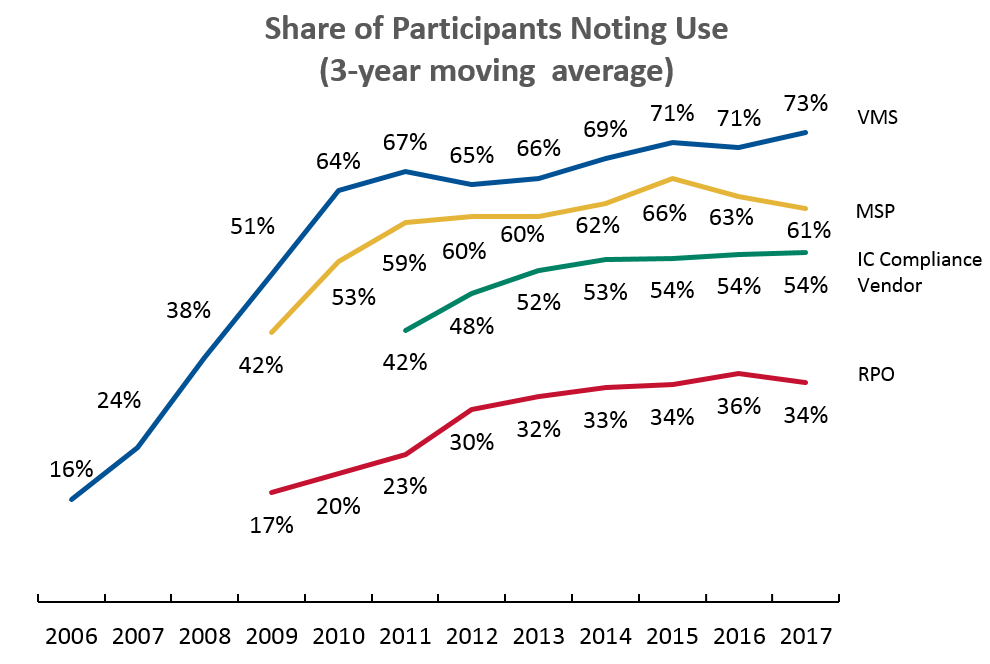 Within the spectrum of the workforce solutions ecosystem, recruitment process outsourcing is an idea that has been around for a long time and recent surveys indicate a low, yet flattening, adoption rate within organizations. SIA started tracking RPO as part of its annual buyer survey in 2009, and since then, there has been only a 17% increase in its use — and only 4% increase in the last five years. In comparison to other technologies and services even in our industry, adoption has been much greater.
Within the spectrum of the workforce solutions ecosystem, recruitment process outsourcing is an idea that has been around for a long time and recent surveys indicate a low, yet flattening, adoption rate within organizations. SIA started tracking RPO as part of its annual buyer survey in 2009, and since then, there has been only a 17% increase in its use — and only 4% increase in the last five years. In comparison to other technologies and services even in our industry, adoption has been much greater.
What is RPO. A service segment of the process outsourcing Industry, RPO is the partial or full outsourcing of the internal recruitment function to a third-party specialist provider, which serves to provide the necessary skills, activities, tools, technologies, related recruitment supply chain partners and process methodologies to assume the role of the client’s recruiting department by owning and managing its recruitment process and related recruitment supply chain partner relationships. RPO is more commonly used as a method for employers to recruit direct-hire personnel, particularly in the US. In Europe, contingent workers will also be included within that scope in some instances.
 Stale and flat. So why has RPO become stale and flat with customer organizations? From my perspective, the answer is simple. The buyers of staffing services are not seeing enough value for the investment they are making specific to RPO solutions. Most RPO solution providers sell a few key value propositions when selling to buyers, such as scalability, cost savings and speed to hire. On paper, all of these sound like great reasons for buyers to move to an RPO solution; however, buyers are proving reluctant to execute. But I expect that to change, as RPO providers find ways to enhance their value proposition.
Stale and flat. So why has RPO become stale and flat with customer organizations? From my perspective, the answer is simple. The buyers of staffing services are not seeing enough value for the investment they are making specific to RPO solutions. Most RPO solution providers sell a few key value propositions when selling to buyers, such as scalability, cost savings and speed to hire. On paper, all of these sound like great reasons for buyers to move to an RPO solution; however, buyers are proving reluctant to execute. But I expect that to change, as RPO providers find ways to enhance their value proposition.
PREMIUM CONTENT: RPO Market Developments
Changing tech. One key way I expect to see this happen is through technology, which is an incredible, ever-changing driving force within the ecosystem. I believe RPO providers will make significant investments in technology that will enable them to outperform internal HR teams currently tasked with filling full-time positions. For example, artificial intelligence is quickly becoming a viable candidate-sourcing technology. There so many organizations developing AI that it is difficult to keep up with them all. Brilent is an example of performing AI and how it compares to human sourcers. Its study pitted AI against some of the top sourcers in the world. The AI finished in third place, but accomplished the task in less than four seconds, whereas the human sourcers took several hours.
I also believe RPO providers will start to leverage experience and technology to map processes and identify opportunities to improve the engagement manager experience. At the end of the day, adoption and results are what will turn the tide for the RPO industry, and in turn for the workforce solutions ecosystem as a whole. The ability to RPO to become a seamless extension of a buyer organization will determine the future success of both. RPO usage undoubtedly will grow, the question is how quickly and who within the providers space will lead the charge of leveraging technology to make RPO a must-have tool in the contingent workforce manager’s toolbox.








